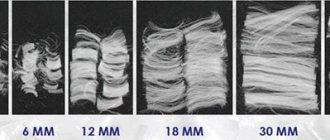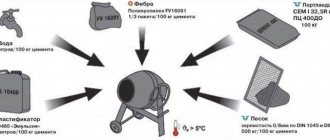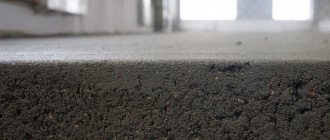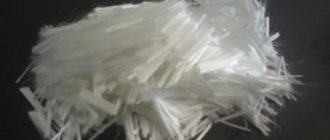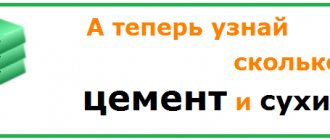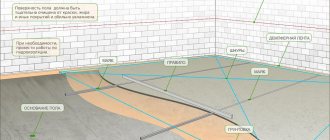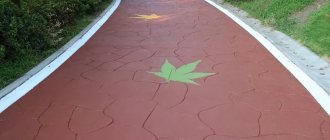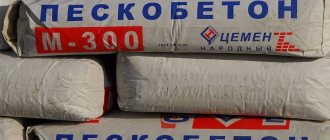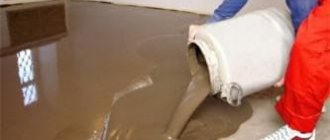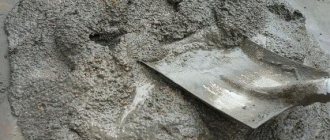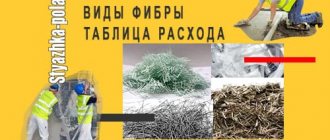Floor screed fiber is made from propylene in the form of a translucent white fiber, with a diameter of 15-25 microns. For better adhesion to building materials, it is impregnated with an oily substance.
Due to the use of material reinforced with fiber, the resistance of the base to abrasion increases, the surface can withstand more freeze/thaw cycles, and the occurrence of cracks and moisture penetration is eliminated.
Fiber fiber: consumption, recommendations for use
| Application area | Recommended fiber size, mm | Fiber consumption |
| Industrial floors, cement concrete road surfaces | 12, 20, 40 | from 1 kg per 1 m 3 depending on the required strength characteristics |
| Screeds, heated floors | 12, 20 | from 0.9 to 1.5 kg kg per 1 m 3 depending on the required strength characteristics |
| Reinforced concrete, concrete structures and products | 12, 20 | from 0.9 kg per 1 m 3 to give structures and products increased strength and eliminate cracks |
| Cellular concrete (foam concrete, non-autoclaved aerated concrete) | 12, 20, 40 | from 0.6 kg to 1.5 kg of fiber per 1 m 3 depending on the required strength characteristics of the finished product |
| Dry building mixtures (self-leveling floors, plasters, putties, grouts, waterproofing, repair compounds) | 3, 6, 12 | from 1 kg per 1 m 3 Dosage depends on the type of dry building mixture, production technology |
| Small-piece products, complex-profile products, small architectural forms | 6, 12 | from 0.9 kg per 1 m 3 Fiber fiber consumption depends on product parameters, dimensions, type of binder, production technology |
| Paving slabs | 6, 12 | from 0.6 kg to 1.5 kg per 1 m³ of mixture, depending on the strength characteristics of the finished product and production technology. |
| Liquid wallpaper, adhesives | 3 | from 0.5 kg per 1 m 3 Dosage depends on production technology |
Method of using fiber fiber
Option 2: Fiber fiber is added to the cement laitance, then all other components of the concrete mixture.
Recommendations for the use of fiber fiber
Volumetric reinforcement of concrete (foam concrete, cement-sand mixtures) using polymer fibers has been increasingly used in the construction industry in recent years. Unlike reinforcing steel meshes, microfibers are evenly distributed throughout the volume of the mixture, improve astringent properties, and make it resistant to delamination.
The use of fiber fiber leads to the fact that concrete becomes more tensile strength, its shrinkage rate decreases, which increases crack resistance. At the same time, the material’s resistance to environmental influences increases: to alternating cycles of freezing and thawing, drying and wetting.
Tests of these reinforcing additives for cement-sand mortars (for screeds) and for foam concrete were carried out at the Rostov State University of Civil Engineering, at the Department of Building Materials. Below, in the table, are the results of studies of the influence of the amount of polypropylene fiber in the mixture on the strength characteristics, on elongation during bending, and on shrinkage of the composition upon drying.
Table 1 . The influence of polypropylene fiber content on the flexural strength of the material and drying shrinkage of foam concrete (fiber length 20 mm)
| Series | Fiber consumption per 1 m3 of concrete, kg | Average density of concrete, kg/m3 | Bending tensile strength | Normalized shrinkage (in the humidity range 5-35%) | General shrinkage (when completely dry) | |||
| MPa | % | Mmm | % | Mmm | % | |||
| F1 | 0,00 | 528 | 0,23 | 100 | 3,55 | 100 | 8,1 | 100 |
| F-2 | 0,98 | 538 | 0,41 | 178 | 3,07 | 86 | 7,2 | 89 |
| F-3 | 1,95 | 530 | 0,54 | 235 | 3,32 | 93 | 7,1 | 88 |
| F-4 | 2,92 | 532 | 0,60 | 261 | 3,67 | 103 | 6,8 | 84 |
The data presented in Table 1 make it possible to conclude: when producing fiber-reinforced concrete grade D500 (the most popular in terms of density), the greatest technical and economic effect will be achieved with a fiber dosage of 0.6 to 2 kg/m3. In this case, the tensile strength during bending increases approximately 2 times, and the normalized shrinkage upon drying decreases by 10-15%.
Table 2 . The influence of polypropylene fiber on the shrinkage of the cement-sand mixture upon complete drying and on the bending strength (fiber length 12 mm)
Fiber consumption per 1 m3 of concrete, kg
strength , MPa
| Series | Bending tensile strength | General shrinkage (when completely dry) | ||||
| MPa | % | Mmm | % | |||
| F1 | 0,00 | 29,2 | 1,63 | 100 | 1,32 | 100 |
| F-2 | 0,95 | 26,0 | 2,27 | 139 | 0,93 | 70 |
| F-3 | 1,43 | 27,1 | 2,56 | 157 | 0,81 | 61 |
| F-4 | 1,90 | 28,7 | 2,80 | 172 | 0,54 | 41 |
As follows from the above indicators, the inclusion of fiber as a reinforcing additive had a significant effect on the tensile strength in bending and shrinkage of the cement-sand mortar upon drying. In this case, the positive effect of fiber is felt when its dosage increases. In cement-sand screeds, the optimal indicator for reducing the risk of cracks during shrinkage is a value ranging from 1 to 2 kg/m3.
Thus, the use of polypropylene fiber can improve the crack resistance of foam concrete and dense sand concrete.
Source
How to make fiber-reinforced concrete?
Initially, the dry components of the solution are placed in a concrete mixer, according to its manufacturing technology, brand and strength class of the material. Depending on where the concrete monolith will be located and under what load it will be operated, the type and amount of fiber fiber is selected. After dry mixing, water is added to the composition, and plasticizers are used if necessary. Thanks to the use of fiber, the amount of water and cement required is reduced.
The mixing time will be 7-10 minutes, while you need to monitor the state of the solution and, if necessary, add water or a plasticizer. This is done to ensure that the mobility of the solution is optimal for the work, there are no voids left in it, and the composition is uniform.
For small volumes in private construction, fiber-reinforced concrete can be made with your own hands in another way. Fiber fibers are filled with water and stirred for uniform distribution. After this, cement or dry construction mixture and other fillers are added to the water until the desired composition is achieved. Constant mixing during production ensures correct distribution of fiber throughout the entire volume of the concrete mixture.
Concrete fiber is becoming an indispensable component of modern mortar. The idea of micro-reinforcement has made this inexpensive material extremely popular, since it significantly improves the quality of concrete and reinforced concrete structural elements. The correct choice of the type and length of fiber, as well as its low price, will improve the strength characteristics and increase the service life of buildings and structures without investing significant funds in it.
Fiber for screed: consumption per 1m3, how much to add
Floor screed fiber is made from propylene in the form of a translucent white fiber, with a diameter of 15-25 microns. For better adhesion to building materials, it is impregnated with an oily substance.
Due to the use of material reinforced with fiber, the resistance of the base to abrasion increases, the surface can withstand more freeze/thaw cycles, and the occurrence of cracks and moisture penetration is eliminated.
Characteristics of fiber
Polypropylene fiber for screed is a complete replacement for metal reinforcement.
It has many advantages compared to metal fiber.
Comparative characteristics of fiber fiber and metal for reinforcement are given in the table:
| Fiber | |||
| Indicators | Polypropylene | Metal | Basalt |
| Destruction due to humidity, corrosion | Not affected | Susceptible | Not affected |
| Electrostatics | Not electrified | Electrified | Not electrified |
| Price | Average | Low | High |
| Strength | Sufficient (0.9-0.95 g/cu m), lower than metal | High | The integrity of the base will be maintained even with through cracking of the concrete solution |
| Use in rooms with high gravity loads, vibration and high traffic | Not recommended | Fits | Can be used in seismically active areas, in the north, and in rooms with high humidity |
The longer the fiber, the more loads the concrete will withstand
The fiber is produced in the form of crumbly material, its fiber length ranges from 6 to 20 cm. The length of the fibers affects the scope of application:
When purchasing, you need to check whether the product has a certificate. If you buy low-quality material, it will not perform the required functions and may release harmful substances into the air.
Consumption
Adding fiber fiber to the screed solution does not in any way affect the proportions of dry components, but it allows you to reduce the amount of water. The application rate is indicated on the packaging, but sometimes it is purchased by weight, without instructions for use, so you need to know the fiber consumption per 1 m³ of screed for each type.
- Polypropylene – 0.9-1.5 kg.
- Fiberglass and basalt - 0.6-1 kg.
- Steel 30-50 kg.
- Carbon – 0.9-1 kg.
It is important! Excessive amounts of reinforcing fiber can impair the strength of concrete, so the specified proportions must be strictly observed.
Advantages of fiber fiber
The fibers are evenly distributed in the cement mortar by thoroughly mixing them and perform the function of reinforcement.
Fiber improves the quality of the mixture and accelerates hardening
Advantages of adding fibers to cement mortar:
It is used to improve the properties of concrete mortar and prepare plaster compositions. It is used in the construction of structures in seismically active areas and areas exposed to aggressive environments.
Fiber fiber screed installation technology
As with the installation of a conventional screed, you need to prepare the surface, mark the level of the subfloor, properly prepare the concrete solution and perform installation according to the described technology for performing the work.
Surface preparation
We remove the old floor covering, inspect the slab for defects and protruding reinforcement.
Sequence of preparatory work:
We stick damper tape around the perimeter of the walls. It will act as an expansion joint when the concrete expands during drying.
Screed level marking
Before you start marking, find the highest and lowest points of the floor
The thickness of the fiber screed and the proportions of mixed materials depend on differences in floor height and the functional purpose of the room.
Find the lowest and highest points on the floor using a laser or water level. We make a mark on the wall, draw a horizontal line along the height of the future screed.
According to the markings, we install the guides parallel to each other in increments of 15-20 cm. We take into account that the distance between the beacons should be less than the width of the tool for distributing the solution. For more information on how to do this using a laser level, watch this video:
We use smooth profiles as beacons and place them in a horizontal plane. To fix a certain height, we use bars or fix beacons to cement mortar.
Using a laser or bubble level, we check that the beacons are installed correctly.
Preparing the solution
We prepare a solution with the addition of fiber for the screed.
There are several ways to mix components:
Preparation of high-quality concrete mortar with fiber:
The solution should have a uniform consistency, like thick sour cream.
We select the brand of cement according to the classification in the table:
| Concrete grade | Application | Cement consumption in kg per 1 cubic meter of concrete |
| M 100 | Lowest strength, used for concreting curbs and fences | 165 |
| M 200 | Used for installation of screeds and foundations | 240 |
| M 300 | It has high strength and is used for installation of foundations, floors, etc. | 320 |
| M 400 | Has the highest strength, withstands load-bearing bridges and overpasses | 417 |
Fiber consumption
The amount of fibers added to the cement mortar depends on the requirements for the screed.
| № | Fiber consumption | Characteristics of the screed |
| 1 | 300 g per cubic meter m | Slightly increases the binding function and makes working with the material easier. This proportion works as an additive that slightly improves the quality of the screed. |
| 2 | 600 g per cubic meter m | The ductility, resistance to moisture penetration, strength and service life of the coating will significantly increase. |
| 3 | 800 to 1500 g per cubic meter m | Maximum efficiency is achieved. |
The minimum consumption should be no less than 300 g. per cubic meter,
The ratio of the number of fibers to a certain volume of cement is indicated on the packaging or in the instructions for the fiber for the screed.
If you add too many fibers, they can cause cracks and splits in the screed.
Filling the screed
Let's look at how to properly make a screed with the addition of fiber. For more information about pouring semi-dry fiber screed, watch this video:
Source
Consumption of cement mortar and fiber
There are several recipes for mixing cement composition with fiberglass. But on average, it is generally accepted that the more of this additive it contains, the better properties it will have. There are certain consumption limits by which you can find out in advance the properties of the future material.
They are designed for 1 m 3 of solution, so:
- 300 grams - acts as an additive, with it the cement composition becomes more plastic and fills all the unevenness;
- 500-600 gr . – the introduction of such a portion increases the strength properties of concrete;
- 800 grams and above - with such proportions the maximum result is achieved; the cement material takes on the characteristics of fiber.
Fiber fiber for screed - consumption per m2 is calculated according to its need per m3
Thin polypropylene fibers of short length can significantly strengthen the cement layer, making it more durable and ductile. Regardless of the percentage of the mixture and for what specific purposes the fiber screed will be used, the consumption per m2 of the surface to be laid is determined according to generally accepted figures relating to the amount of fiber for 1 m3 of solution. The calculation is made taking into account the thickness of the concrete layer and the area of the room being equipped.
Properties and qualities
Polypropylene fiber is added, among other things, to semi-dry screeds.
Fiber fiber is evenly distributed throughout the entire volume of the mortar mass, which prevents further formation of cracks and shrinkage, reduces the abrasion coefficient of the surface and reduces the moisture absorption rate. Fiber is an artificial material in the form of polypropylene fibers of translucent white color. Their diameter is about 20 microns, and their length ranges from 3...18 mm. Moreover, each size has its own area of application:
Reinforced fiber is characterized by low electrical conductivity and has a sliding effect, ensuring the most uniform mixing of fiber with cement. As a result, the composition acquires viscosity, which subsequently affects the good density and load-bearing capacity of concrete.
High-quality fiber fiber has no obvious disadvantages. Another thing is an uncertified product from an unknown manufacturer. Over time, if not immediately, such material may begin to release hazardous substances that can cause harm to health. This is very dangerous, especially when laying mortar in residential areas.
As a result of using a polypropylene fiber solution in a batch, a new material appears that has a lot of positive properties. This type of concrete:
Fiber fiber compares favorably with metal fine-mesh reinforced mesh. Its individual particles do not lie in a single-level layer and do not bunch up into lumps, but are evenly distributed throughout the entire volume of the screed or concrete structure. The growing popularity of polypropylene is also facilitated by its affordable price and compatibility with additives intended for concrete solutions.
The fiber reinforced screed has a perfectly flat surface, just like a layer of plaster applied to the wall.
How to determine fiber consumption per 1m2
In a high-quality mixture, all ingredients must be thoroughly mixed. This can be achieved by first combining the dry cement composition with the required amount of polypropylene fibers. Water should be added to the solution in portions, bringing it to the desired consistency.
Kneading recipes depend on the requirements for the finished composition. For 1m3 of solution it will go:
If we consider the consumption of fiber fiber per 1 m2 of cement screed, then we will have to focus on the thickness of the layer being laid. For a 50mm high strength leveling deck you will need 40g of fibre. The figure did not come out of thin air, but from an ordinary mathematical proportion.
The fact is that a volumetric cube differs from a flat square in the presence of a third dimension, namely depth. For meter cube sizes it is 1000mm, and for our screed it is 50mm, i.e. 20 times less. Consequently, in this case, fiber fiber will be needed the same amount less. So, 800/20=40g. To obtain the final calculation, the actual area of the room in m2 should be increased by 40 times. The resulting figure will indicate the amount of fiber in grams. In fact, everything is simple and clear.
Features: pros and cons
Fiber fiber is an artificial filler for cement mortars. It is produced in the form of small flakes that are easy to mix with other components of the mixture.
Fiber-based solutions have several significant advantages over classic products:
- Fiber fiber screed has increased bending strength. A foundation made of such materials perfectly withstands shrinkage of buildings, heaving of soils and many other loads.
- Cement mortars almost never delaminate after hardening. This is achieved due to fibers that are randomly located in the structure of the substance.
- Fiber fiber prevents the screed from cracking. But this effect is achieved only if the exact proportions recommended by the manufacturer are observed.
- Fiber cement mortar can be prepared using a small amount of water. This, in turn, accelerates the hardening of the mixture and does not allow microvoids and other negative components to form inside the structure.
- Fiber fibers are obtained from materials that do not rot or collapse under the influence of external factors.
- Once hardened, cement is not easy to wipe off, which affects the service life of both bases and decorative materials.
- The addition of fiber fibers to concrete affects the quality of waterproofing of the material. A frozen base does not allow moisture to pass through or absorb moisture.
- Fiber-based surfaces can withstand low sub-zero temperatures, at which it is not recommended to use pure concrete.
As for the disadvantages, fiber fiber and products based on it have practically none.
Types of material
Steel additives
Steel fiber is made from wire and added to cast elements when decorating various structures.
Steel fiber for concrete is made from low-carbon wire, the diameter of the metal elements varies from 0.7 to 1.2 mm, and the reinforcing cellulose has a length of 25-60 millimeters. With the help of additives, the quality of concrete products, paving slabs, surface coverings, road surfaces, airfield strips, cast fences or architectural monuments made of concrete composition is strengthened. Metal fiber is included in the solution for cast decoration elements, such as fountains, balustrades, and decorative elements for architectural designs. Concrete with steel fiber is laid in two ways:
Polypropylene
Polypropylene fiber for concrete is a common type of reinforcement for concrete structures. Release form: substance packaged in bags. Material Objective:
Additives from basalt
Basalt fiber is used to strengthen the mechanical properties of a material with a porous structure. Added to the composition of gypsum products. The length of basalt threads differs from the parameters that other types of additives have, so the calculation of the material is regulated individually, depending on the specific case and characteristics of operation. The properties of the finished product depend on factors such as fiber consumption.
Fiberglass
Fiberglass does not dissolve in the concrete mixture, but is a reinforcing additive with increased strength. Fiber for reinforcement is crushed reinforcing glass fiber in the form of narrow strips of different lengths. It differs from other additives in its increased strength and modulation flexibility. Such properties make it possible to positively resist the development of an acid-base environment in a restored structure. The material is added at the time of mixing the solution. The substance does not have the properties to dissolve, but is contained in the composition as individual microparticles. Microfiber is invisible in an already erected structure.
Method for producing concrete based on steel fiber
The production of fiber and building mixtures based on it is streamlined and fully automated at modern enterprises.
Manufacturing of metal fiber
To obtain anchor fiber, low-carbon steel wire is cut. Cold-rolled steel sheet is often used for this. The resulting blanks can have different thicknesses, generally from 1 mm or more. Thin rods are more expensive because they have better performance characteristics. In some cases, their use is completely justified. For example, in road construction, steel fibers with a diameter not exceeding 0.8 mm are laid in the roadbed. Otherwise, metal fibers exposed over time will pose a danger to transport.
The fiber additive is produced using special milling equipment. When cutting, the metal is exposed to high temperatures, which is why the finished rods have a specific blue tint. This bluish oxide layer protects the metal from corrosion.
A number of operations carried out make it possible to include even such measures as, for example, magnetic orientation into the manufacturing sequence. It is carried out while the workpieces are still on the conveyor. Thanks to it, during the operation of metal blanks there is no formation of lumps magnetized to each other, which is unacceptable in ready-made concrete. As a result, the products are packaged in packaging bags of different sizes, from 1 to 25 kg.
Concrete mixing technology
To combine fiber with cement mixtures, you need a concrete mixer or mortar mixer. The following technology is most often used in industrial production:
- cement of the required grade, sand, gravel and fiber fibers are poured into the concrete mixer;
- water is added in the required proportion specified by the manufacturer;
- everything is mixed for 5-10 minutes;
- for greater elasticity, a plasticizer is added to the mixture;
- The finished building composition is delivered to the site within half an hour.
To further compact concrete particles, it is customary to use vibrators in the construction industry. With their help, the cement mixture is compacted, and this affects the strength of the finished structure and prevents its separation into separate layers.
The use of metal additives in the form of wire can also be used in independent construction. The method of adding fiber to concrete is very simple:
- prepare a dry sand-cement mixture;
- pour it into the mold;
- add the required amount of fiber;
- metal rods are evenly distributed;
- fill with water.
You can add fiber to mortar or concrete at any stage of preparation. It is important to distribute it well and form a structure. It is necessary that maximum fiber reinforcement be achieved throughout the entire structural volume. And to make it easier to work with the concrete mixture, plasticizer additives are added to the composition.
DIY concrete additives
The basic characteristic of concrete and cement-containing mortars is the compressive strength of the finished products. The process of setting and strengthening of the poured mortar is tied to the hydration of the cement.
The minerals included in its composition react with water and atmospheric carbon dioxide, which leads to the creation of a strong crystalline structure, which, in turn, binds the filler: sand, gravel, slag, crushed stone, expanded clay....
In this article we will touch on the main additives in concrete and cement mortar, which modify their properties and which you can make with your own hands in the living conditions of an apartment or cottage.
DIY cement mortar and concrete, what it is and why - introductory
In fact, this is the simplest version of concrete: a mixture of cement mortar with coarse sand.
It is mainly used as substrates for foundations or as a filler for metal forms (piles).
Very little water is required for the solution - only for convenient stirring and hydration of the cement. It is possible to mix the mixture directly in the pouring mold or formwork.
Usually crushed stone with a fraction from 2-3 mm to 30-35 mm is used
Important!: crushed stone, like any other filler, must be clean! It is also recommended to use aggregates of different sizes with non-smooth surfaces, i.e.
extracted by crushing rocks.
In the recipes below we will assume that 1 bag of cement is 50 kg. unless explicitly stated otherwise.
So, how to prepare concrete yourself:
Proportions in concrete preparation technology are not given, because For different purposes, different compositions are required.
Foundations for a house or large buildings require the inclusion of large aggregates and the cement mortar needs to be sufficiently fluid and in an amount sufficient to adhere/fix them.
The most common proportions of concrete mortar are 1:3:6, where respectively cement, sand and aggregate + 0.5-1 water. The component-wise composition of concrete is set out in GOST 7473-94 and SNiP 5.01.23-83.
DIY plasticizers
History knows many recipes and techniques for improving the characteristics of concrete.
For example, already in the 19th century, to increase plasticity and adhesion, protein from a chicken egg was added to the solution; in the 20th century, after the advent of slaked lime (fluff), they switched to it. Nowadays, at home, washing powder or other detergents are sometimes added.
Using fiberglass for floor screed
Fiber fiber for floor screed is a rather unique substance that is used to give the flooring a reinforcing effect. The fact is that standard solutions for such an event have significant drawbacks. Thus, the mixtures used to level the floor surface shrink quite strongly, which causes cracks to appear and the base loses its strength. It is fiber that eliminates these problems and does not increase the weight of the overall structure.
Advantages of fiber fiber
The fiber used for the screed consists of polypropylene fibers. This material is classified as artificial and consists of white fibers up to 20 mm long with a diameter of up to 20 microns. To increase the adhesion of the material to the building mixture, it is additionally treated with oil components.
Fiber fiber helps give the solution a number of improved characteristics, including:
It is noted that this material has virtually no disadvantages. A significant problem that may arise is the purchase of a low-quality product. This often happens due to the choice of untested products from a dubious seller, which have a lower price. The consequences of such use are quite difficult to predict. The fact is that the solution not only may not obtain the necessary characteristics, but also the fake fiber will release substances harmful to human and animal health.
On a note! To avoid negative consequences, it is necessary to give preference to hardware stores with a trustworthy reputation and certificates for the products they sell.
Material and its features
Fiber for floor screed is a truly unique material. Many craftsmen note that using it together with plasticizers significantly increases the overall reliability of the structure.
When pouring the solution, several stages can be distinguished that determine the characteristics of the fiber:
Fiber fiber increases the plasticity of the solution used. It must be borne in mind that this quality is maintained even after final drying. This allows us to cope with the problems that arise in newly built apartment buildings and private buildings that are subject to constant shrinkage.
On a note! Many experts note the need to use fiber as an additional construction component in places with increased seismic hazard.
The consumption of fiber fiber depends on what effect is planned to be achieved. The fact is that the qualities that the floor screed solution acquires depend on the amount of substance used.
So, per 1 m3 of solution there is the following amount of additive:
On a note! It should be borne in mind that consumption per m2 is not entirely appropriate when calculating this material. The situation is complicated by the fact that in the calculation it is necessary to focus on the thickness of the flooring. Therefore, for 1 m2, taking into account a thickness of 5 cm, at least 40-45 g of fiber fiber will be needed.
Performing a semi-dry screed
Filling the screed with fiber is carried out in the following sequence:
After a few days, you can begin to carry out subsequent finishing work, which may consist of laying laminate or parquet boards.
Manufacturers
Fiber fiber is a fairly popular building material that can be purchased almost everywhere. Today, these products are produced by several companies, among which are:
- Propex;
- Fibrin;
- "Fiber fiber";
- "Fibrin";
- “VSM fiber fiber” and many others.
Products of these brands are distinguished by high quality and safety.
Before purchasing them, you should definitely familiarize yourself with the technical parameters of the fibers in order to choose the best option for solving specific problems.
How to reinforce a screed with material
Before tiling the floor, it is first filled with a cement composition to level it and make it more reliable. The solution is made from cement, sand, polypropylene fiber and water. In addition to the materials listed, you will need the following tools:
First, the foundation is prepared. Debris is removed from it, and then cracks and recesses found on the floor are sealed using putty. After this, wash it and wait until it dries completely.
You can learn how to prepare cement mortar for plastering walls from this article.
Then the levels are set with marks on the walls. This stage of work begins from the corners of the room. Instead of beacons, wooden blocks or self-tapping screws with plastic tips made from corks are used. They must be fixed with cement.
After such preparatory work, you can proceed to preparing the solution. First, the dry ingredients are mixed - sand and Portland cement. The proportions are maintained at 3:1. Then half the volume of fiber fiber is added to them. After thorough kneading, the mixture is diluted with water, and the remaining fiber mass is introduced in small portions. If you use traditional technology, it is useful to read about what mixtures are used for floor screed.
In the video, reinforcement of the screed with fiberglass:
If such a fiberglass screed is used to create a heated floor, thermal insulation must be provided. It is laid on a dried base, and after it is filled with the prepared solution. Typically the layer thickness is 30-50 mm. The plane is leveled using a rule. Please note that the next layer is applied only after the previous one has dried.
After leveling, the resulting surface is rubbed with a grinding device, which hardens the surface. It is produced 20 minutes after pouring. The resulting screed must be covered with polyethylene to protect it from drafts. For proper hardening, it must stand for at least 12 hours. After four days, a decorative layer of the selected floor covering can be laid on its surface.
Fiber fiber is an excellent alternative to reinforced mesh. It costs less, and gives the cement screed properties that the latter cannot distinguish. The work will not take much time; the only factor on which the quality of the screed will depend is the correct creation of the solution and its pouring. You can do it yourself, but for those who doubt their abilities, it is better to hire specialists. In any case, when performing such a screed, the base will be smooth, frost-resistant, moisture-resistant and thermally conductive.
Why add a reinforced layer?
Cement screed is not reliable and over time, under the influence of various factors, it begins to crumble and become covered with cracks. Its ideally flat surface is achieved with great effort. To facilitate this work, a reinforced layer is first laid on the treated area, often a steel mesh is used for this. But on large areas it does not help create a flat surface. It is for these purposes that polypropylene fiber is used; it costs less than its steel counterpart and is mixed together with cement. Its structure is compatible with all additives used to create concrete.
Technical characteristics of cement-lime mortar grade 75 are given in this article.
The video shows a fiber reinforced screed:
What is the composition of the mortar for plastering walls is indicated here.
The quality of such a solution depends on homogeneity - all particles must be evenly mixed together. This is achieved by portionwise introduction of fiber into the composition. The best method is to mix part of the material with a dry cement mixture, and then mix it with water and then adjust the solution to the desired consistency. The fiber fills all the voids and prevents the cement material from hardening in pieces. The quality of the resulting screed directly depends on its volume used.
It is also useful to read about the pros and cons of dry floor screed.
Technology of use
All stages of creating fiber-reinforced coatings are so worked out and verified that obtaining the correct result without defects is possible even without turning to professionals, when working independently. To fill a reinforced screed, you must have the following tools and materials:
The stages of work are as follows:
The reinforced screed is ready. You can begin laying the final decorative coating.
You will learn even more information about fiberglass for floor screed in the next video.
Types of additives
As it became clear from the above material, the reinforcing component can be made from various bases. Now let's take a closer look at each type of fiber fiber.
Steel
Steel fiber is most often used in the production of concrete structures, paving slabs, cast fences and cement monuments. It is added to the solution when pouring molds for fountains, balustrades and various massive decorative elements of outdoor architecture.
Polypropylene
Polypropylene fiber is considered the most common component that strengthens building mixtures. Its popularity is explained by its affordable price and decent performance.
From cement mortars with this additive, foam concrete and aerated concrete blocks, roadside curbs, fencing panels, etc. are produced.
Basalt
Basalt fiber, like polypropylene, gives strength to blocks with a porous structure, and is also often used to create gypsum objects.
In this case, the length of the fibers may differ, so its consumption is regulated individually, and the finished products will have different properties.
Fiberglass
Fiberglass fiber is added to concrete to give it plasticity. It is lightweight and is loved by architects who often work on voluminous, curved decorative objects. Mortar with the addition of fiberglass can often be found in restoration areas and when repairing architectural monuments.
Application area
The presented reinforcing additive can be mixed into any solutions and compositions based on cement and even lime or gypsum. It is more advisable to use it in cases where the structure will obviously be subject to shrinkage and, as a result, cracking. And also due to various mechanical influences possible in a particular case.
Steel fiber is used:
- when forming prefabricated and monolithic reinforced concrete structures of the building frame (wall panels, columns, floor slabs, foundations);
- for road repairs, production of reinforced concrete slabs and road surfaces, including highways and airfield runways;
- in the construction of earthquake-resistant and hydraulic structures, landslide protection and other coastal structures;
- when installing concrete screed floors, including self-leveling ones;
- for creating small structures (curbs, street tiles, finishing stone);
- in architectural projects for the installation of decor, monuments, statues, fountains;
- in the production of concrete fences and fences;
- in plastering walls, making foam concrete blocks and gypsum mortars.
Features of fiber fiber
The use of fiber increases the reliability of the structure by 90%, provided that good quality plasticizers are also added to the composition.
When used in the poured layer, cracks do not form at absolutely all stages of hardening:
Fiber fiber can reduce the moisture absorption properties of concrete. This is possible because the pores become smaller. It is more difficult for water to find passages and penetrates much more slowly. Due to this property, fiber fiber is used in the construction of settling basins for water, structures in seas and rivers.
Thanks to polypropylene fiber, the plasticity of concrete becomes several times greater. This characteristic is inherent not only in the solution, but also in the finished hardened structure made from it; it can withstand impacts and suppress vibrations. This material characteristic is used at military sites and in heavy industry. Structures built using fiberglass can withstand earthquakes and are highly resistant to explosions.
A very important characteristic is the abrasion of surfaces. Very rapid wear is inherent in those concrete structures that are used in a rather aggressive environment
For this reason, dams, reservoirs and water barriers are often built using a mixture of cement and fiberglass.
This material also has high frost resistance, and concrete takes on this quality. At the same time, its resistance to sub-zero temperatures becomes several times higher.
If a solution with the addition of polypropylene fiber is mixed in accordance with the technology, then the adhesion of the resulting concrete to the surface will be much improved and it will be easier to level it on it.
Universal reinforcing agent
First of all, you need to know how to make a screed in special conditions, how to make a dry mixture, how thick it should be, how long does it take to dry? One of the most common reinforcing materials is polypropylene fiber.
At the moment, there is no more effective “additive” for concrete that would ensure its resistance to chemicals, moisture, and physical impact.
Fiber fiber
The main raw material for the manufacture of such a seal is polypropylene, the threads of which are intertwined, creating a kind of network. In order for the fiber to penetrate better into the building mixture, a layer of oil is applied to the fiber.
So, it easily combines with cement and water to give them the necessary strength. The fibers have low electrical conductivity, which is also important for a normal concrete floor.
For more information about concrete floor screed with the addition of fiberglass, watch the video:
